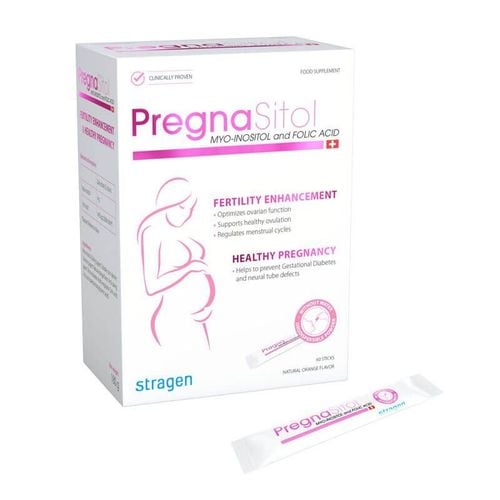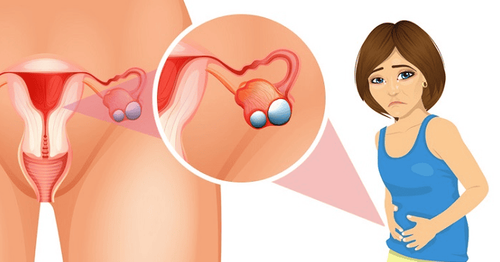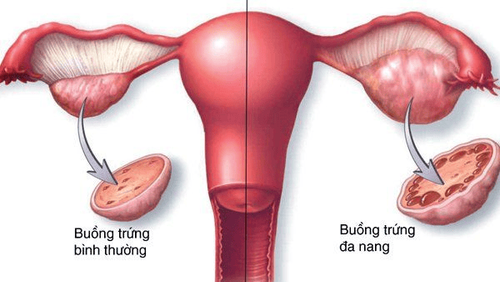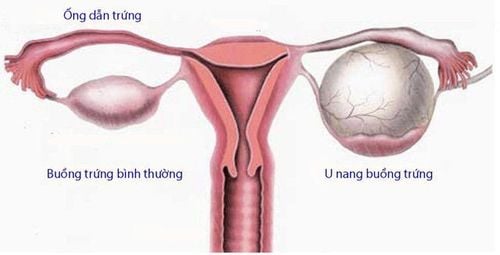This is an automatically translated article.
The article was professionally consulted with Specialist Doctor Obstetrician and Gynecologist - Department of Obstetrics and Gynecology - Vinmec Hai Phong International General Hospital.
Ovarian cyst rupture and rupture of an ovarian cyst can lead to pain and bleeding. The condition is usually not dangerous, but sometimes people need immediate medical treatment to avoid possible complications.
1. What is an ovarian cyst rupture?
A cyst is a fluid-filled sac. Occasionally, cysts can form on the ovary forming an ovarian cyst. Ovarian cysts are a common condition and tend to improve on their own. Although most cysts are harmless, sometimes cysts can rupture if they are too large.
Rupture of an ovarian cyst can lead to sudden pain just below the navel. The location may vary depending on the ovary containing the cyst.
2. Causes of ovarian cyst rupture
Ovarian cysts can rupture on their own, either because the tumor is twisted many times or caused by a strong impact.
The fluid inside the tumor accumulates more and more, causing the tumor size to increase gradually, the shell of the cyst will stretch and may burst if there is no longer enough capacity.
In the case of large cysts, with a long stalk that is twisted many times, causing the blood vessels in the cyst stalk to become congested. At that time, the ovarian cyst gradually became necrotic and ruptured, and the fluid spilled into the abdominal cavity.
This is the reason why pregnant women with ovarian cysts are more likely to experience torsion and rupture of the cyst. The reason is that as the fetus develops, the uterus gradually expands and pushes the ovaries up, so there will be more space around the ovary, so the cyst is easy to rotate and twist and then burst. .
In addition, there is another common cause that is also the reason for the cyst to burst, which is the impact of external forces such as a strong impact on the abdomen, sex in positions of strong pressure on the abdomen. , a lot of sports activities cause the tumor to be pinched and ruptured.

3. Signs of ovarian cyst rupture
Ovarian cysts are the most common tumor in the female body. It accounts for about 3.6% of gynecological diseases. Many women have ovarian cysts but do not know it because the symptoms of the disease are very vague. The disease is only discovered accidentally during a gynecological examination or until complications occur with rupture or torsion of the cyst.
Large ovarian cysts are very fragile, they can burst at any time. Here are some symptoms when a woman has a cyst burst:
3.1. Severe abdominal pain The ruptured cyst causes blood and fluid to overflow into the abdomen causing very severe pain and suddenly feels like a knife stabbing in the abdomen.
Pain is located in the lower abdomen, if the ruptured cyst is on the left ovary, the patient will have pain on the left side of the abdomen and vice versa if the ruptured cyst is on the right side, the patient will have abdominal pain on the right.
3.2. Nausea and vomiting Ovarian cyst rupture causes nausea or vomiting of food, fluid or blood (rarely occurs) out. Usually, medical professionals will take a sample of a patient's vomit to check for a ruptured ovarian cyst.
However, this symptom is often confused with many diseases of the gastrointestinal tract, so for an accurate diagnosis, doctors need to conduct ultrasound, CT scan and other necessary tests before surgical intervention. art.
3.3. Symptoms of shock In severe cases, when the tumor ruptures, the patient will lose a lot of blood and may fall into a state of shock, causing the body to quickly become weak, pale, and sweaty. , dizziness, dizziness, blurred vision.
4. Complications of ovarian cyst rupture often occur with which type of cyst?
There are 2 types of ovarian cysts in women, in which 90% are benign functional cysts (ovarian cysts, thyroid cysts, luteal cysts), the remaining 10% are organic cysts (cysts in the ovaries). water, skin cyst, mucinous cyst) – pathological tumor.
Most functional cysts atrophy after a few menstrual cycles without causing any dangerous complications, this is just a normal physiological condition so it is not a cause for concern.
Particularly for organic cysts, rupture complications often occur with water cysts because they have a rather thin shell and long stalk, so they are easily twisted.
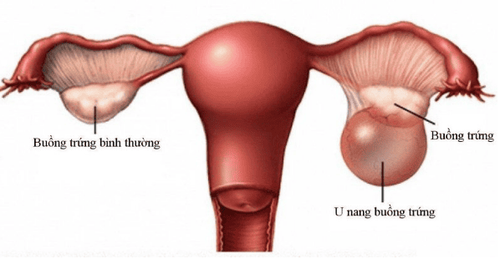
5. Is ruptured ovarian cyst dangerous?
Ovarian cyst rupture is an acute complication that needs to be treated quickly, otherwise the patient can fall into a critical state.
When an ovarian cyst ruptures, the blood and fluid in the cyst will overflow into the abdominal cavity causing infection. The patient may have pelvic peritonitis. This is a very serious surgical disease, pelvic peritonitis is the final stage of the intra-abdominal infection process. At that time, many types of highly toxic bacteria will spread to all organs in the abdomen, toxicity is released very quickly leading to shock and intoxication. If the patient is not treated promptly, the mortality rate can be up to > 60%.
More dangerous, if the ovarian cyst ruptures, it is a mucinous cyst because the fluid of this type of cyst is difficult to wash. If during surgery, the doctor does not clean it, the remaining diseased cells will stick to the abdomen, creating countless other small tumors in the abdomen, over time the patient will gradually deplete and endanger the life of the patient. network.
6. Diagnosis and treatment of ruptured ovarian cyst
Timely diagnosis and treatment is the best way to prevent complications that affect a woman's fertility. Some common diagnostic and therapeutic measures are as follows:
6.1. Diagnosis To diagnose a ruptured ovarian cyst, your doctor may conduct an examination of your symptoms and medical history. Therefore, tell your doctor if you or anyone in your family has ovarian disease, breast cancer, ovarian cancer, or polycystic ovary syndrome.
Besides, the doctor may order some diagnostic tests for ruptured ovarian cysts. Common tests include:
Ultrasound: Can help your doctor recognize cysts on your ovaries. If the cyst ruptures, an ultrasound can show fluid around the ovary. Even ultrasound can show lesions and rupture sites. Blood test: Used to check for pregnancy or ectopic pregnancy. Blood tests may also be used to check for signs of infection or a tumor. 6.2. Treatment of ovarian cyst rupture The treatment for a ruptured ovarian cyst usually depends on the size of the cyst and the age of the patient. Treatment may not be necessary if the cyst is small and the body absorbs fluid when the cyst ruptures. If the body cannot absorb the fluid, treatment may include:
Treatment for a ruptured ovarian cyst usually depends on the size and age of the patient
Over-the-counter pain relievers (NSAIDs) such as Ibuprofen May help reduce swelling, pain, and fever. Certain types of NSAIDs can cause stomach bleeding and some kidney problems. Therefore, talk to your doctor before using the drug. In addition, do not use the drug for children without consulting a doctor. Prescription pain relievers such as those containing Acetaminophen or Morphin Sulfate. Acetaminophen overdose can cause liver damage, constipation. Therefore, use the drug as prescribed by the doctor, do not arbitrarily add or skip doses. Antibiotics may be prescribed to prevent infection or fight bacterial colonization. Blood transfusion if severe bleeding can affect the health and life of the patient. For large or complex cysts, your doctor may recommend laparoscopic surgery for treatment. Surgery can remove fluid or blood in the area of the ruptured cyst. Dead, broken cells outside the cyst may also require surgery to remove. Surgery usually includes:
The doctor makes a small cut in the patient's abdomen. Then proceed to remove the tumor through the cut. After surgery, your doctor may recommend some imaging tests to check for the condition of the cyst. Cysts can be tested in a laboratory. If the membranous cyst is cancerous, your doctor may recommend a more specific treatment plan.
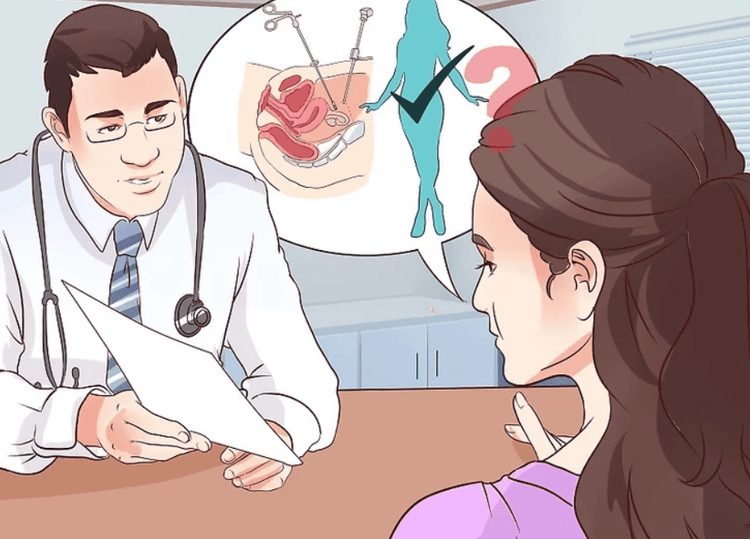
7. Measures to prevent ovarian cyst rupture
There is no way to prevent ovarian cyst rupture. However, the patient can note some measures to limit the rupture of cysts as follows:
Apply heat as directed by the doctor. This can reduce pain and irritation in the cyst. In addition, taking a warm bath has the same effect.
Follow up the cyst as directed by a specialist. Patients can also have an ultrasound of the ovaries every 2-3 months to check and prevent cyst formation.
Talk to your doctor about using regular birth control pills to reduce the risk of cysts forming.
An annual pelvic exam can prevent pelvic inflammatory disease, cyst formation, or cancer.
Rupture of ovarian cysts can lead to scarring and infertility, although this is rare. Rupture of an ovarian cyst is rarely dangerous, but sometimes it can lead to severe blood loss, shock, and even death. Therefore, go to the hospital and talk to your doctor about the risks and measures to treat and prevent complications. Ovarian cysts, if not detected early and treated promptly, will cause many serious complications including infertility, even life-threatening. Currently, Vinmec International General Hospital provides a full range of treatment methods for ovarian cysts such as open surgery, laparoscopic surgery, robotic laparoscopic surgery. Vinmec is one of the first units to successfully apply laparoscopic ovarian cyst surgery by robot. This method has high accuracy, low complications, safety, pain relief, quick recovery, high aesthetics performed by highly qualified and experienced doctors. After surgery, patients can use Vinmec's Enhanced Recovery After Surgery (ERAS) service, which also helps patients quickly recover and reduce hospital stay after surgery. Patients will be cared for 24/24h and monitored continuously for at least 2 days after surgery with modern equipment.
In addition, to ensure the earliest possible recovery and reduce pain for the patient, the team of anesthesiologists, physiotherapists, and nutritionists always accompanies the patients.
If you have a need for robotic laparoscopic examination and surgery at Vinmec, please book an appointment directly at the website or contact the hotline system for detailed advice.
Please dial HOTLINE for more information or register for an appointment HERE. Download MyVinmec app to make appointments faster and to manage your bookings easily.




